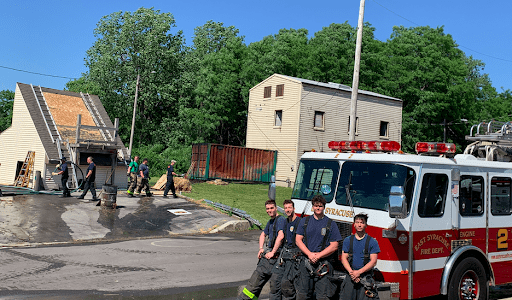For my first AMS project, I decided to focus on continuing my education and training in the volunteer fire service. I joined the Hamilton Fire Department (HFD) in my first year at Colgate and immediately loved it. After COVID-19 hit and everyone was sent home, a few other students and I stayed in Hamilton to finish up basic training. I have spent every summer since in Hamilton, continuing to respond to calls and attend training as a member of HFD. Last summer, I wanted to turn my training into a more formal project. With AMS funding, I was able to complete a Firefighter II course through Madison County, attend training put on by the New York State Association of Fire Chiefs (NYSAFC), train with the department, train on my own, and continue responding to emergency calls.
The central theme of the Firefighter II course is to prepare firefighters for leadership roles. We sought to understand fire conditions and picked up various skills that are expected of fire officers. We complemented Powerpoint presentations with practical skills sessions, learning about sprinkler systems, vehicle extrications, building construction, gas leaks, and general fire safety, among other topics. Some of the best training involved simulated structure fires, in which we had to identify where the fire was located, if there were any victims inside the building, if there was any suspicious activity, and any other details pertaining to fire attack.
The first fire engine would arrive on scene at the Madison County burn tower and communicate an initial size-up along with resources needed. Other fire trucks would respond as requested and follow the instructions of the fire officer on scene. Generally, the search team (used to find victims) would enter the building first, and the hose team would advance shortly after. Additional units to the scene would be designated as second hose teams or additional search crews as needed.
The most interesting part for me was trying to remove a dummy victim hanging out of a second floor window. My partner and I threw a ground ladder onto a garage roof to make access to the window. We pulled the dummy out of the window and down the ladder, before making our way into the structure to complete a second story search from the inside. Trainings like these prepared us for the unpredictability of fires and the considerations that need to be made before, during, and after the fire.
Through the NYSAFC flashover simulator, I was able to observe fire behavior in a controlled environment. In my opinion, this is the closest you can get to the heat of a real fire without actually being in a real fire. The instructors lined one segment of a shipping container with OSB wood and lit it on fire. The students were in full personal protective equipment (PPE) on the other side of the shipping container. While we were protected from burns, we were exposed to intense heat and smoke. We were shown how the fire behaved as we withstood the heat. To see the full experience you can watch the video I put together.
Through each round of fire, the container and our PPE became hotter and hotter. My heart was racing and I could feel my air pack straps burning into my shoulders. One of the masks on a firefighter began to crack. Others couldn’t handle the heat and left the burn pod. I knew I had a limit, but I also didn’t want to quit in front of my instructors and peers. Finally, the remaining students agreed to leave together. The instructors told us afterwards that, in addition to instructional learning, they were testing our physical limits. As firefighters we need to find the line between perseverance and ego. Recognizing when it’s too hot to handle is vitally important.
The other NYSAFC training was part of the Conference and Fire Expo in Syracuse. I attended the truck company operations class with a few other HFD members. We reviewed forcible entry, search and rescue, and basic ladder operations. The coolest part of the training was seeing Madison County fire instructors, learning from retired city firefighters, and being able to use the Syracuse Fire Department training grounds.
Department training was generally focused on aerial ladder maneuvering and flowing water. On my own time, I reviewed other skills such as roof venting and victim search and rescue. I looked at a few online firefighting courses and completed cardio and strength workouts in full PPE and breathing air from a pack. I also mentored new drivers as they learned to drive our EMS response vehicle, 195-1.
My time in HFD this summer and throughout the years has been extremely rewarding. I learned new skills and improved as a firefighter. I would highly recommend that new Colgate students consider joining HFD and the fire service.
